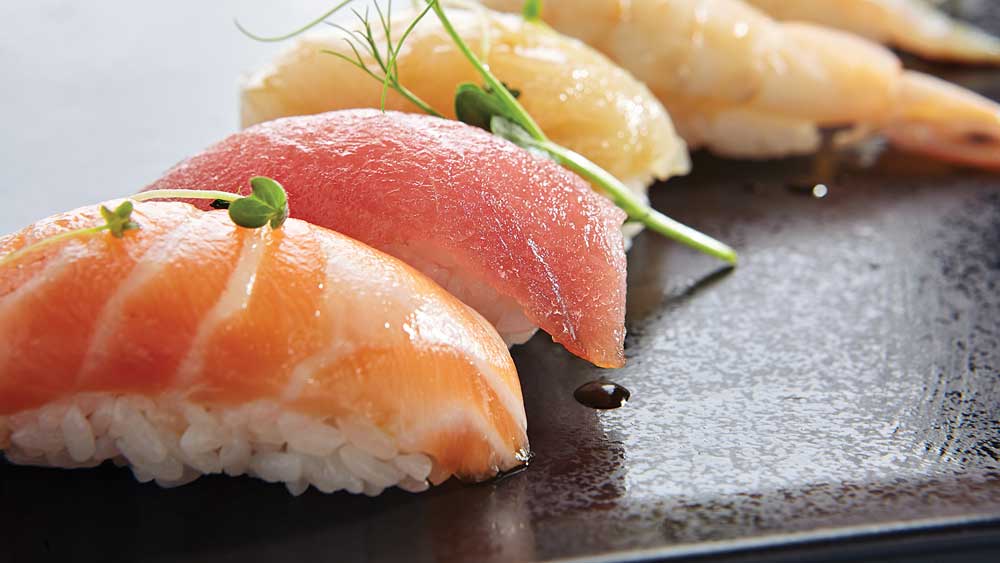
It’s interesting how relatively commonplace sushi has become in America. Not only can you find it served in Japanese and “fusion” restaurants all over the country, but supermarkets routinely stock fresh sushi in their takeout departments. Sushi in Japan has an ancient history, however. The oldest form, well over 1,000 years old, is called Nare-zushi. It was a way of preserving fish by fermentation at a time when there was no refrigeration. The fish, rice and salt were layered and then weighted with heavy stones and allowed to ferment for one to three years after which the fish was eaten and the rice discarded!
This evolved over a long time and many variations into the sushi with which we are most familiar, Nigiri-zushi, or hand-formed sushi. It is relatively new having made its debut in Tokyo in the early 19th century. In Nigiri sushi the early principles of fermentation, salt and stone weights were replaced by rice vinegar as the fermenting agent in the rice, salty soy sauce as an accompaniment and pressure from the hands or bamboo rolling mat for the stones.
A whole universe of fish, shellfish, vegetables, seaweeds and seasonings are now used in making contemporary sushi. You’ll find versions in which the rice is replaced by noodles of all kinds and unstructured versions called Chirachi sushi, in which the rice is put in a bowl with various ingredients topping it. It’s a complex world and very fun to dive into if you have the inclination.
The traditional beverage served with today’s sushi has usually been sake or maybe beer, especially light lagers and pale ales. Both of these help cleanse the palate and are relatively delicate in flavor so as not to interfere with the subtle flavors of sushi. The conventional wisdom among many sushi aficionados is that wine is often too powerful and robust to complement sushi. This doesn’t mean that there aren’t wines that can work well in this environment, but you must choose carefully. The mantra here is “delicate”!
 From a flavor standpoint we want to look for wines that have the ability to work with the salty, sweet, acid and peppery flavors (the latter from the traditional wasabi served as a condiment). Not an easy dance for wine. Heavily oaked, high-tannin wines are definitely not at home in this environment. Whites as a rule are the best matches but some reds can work.
From a flavor standpoint we want to look for wines that have the ability to work with the salty, sweet, acid and peppery flavors (the latter from the traditional wasabi served as a condiment). Not an easy dance for wine. Heavily oaked, high-tannin wines are definitely not at home in this environment. Whites as a rule are the best matches but some reds can work.
Here are some simple recommendations for wines that work best with sushi. Remember that depending on the ingredients used this can vary, but these are good general guidelines. The sake flavor profile is a good example to keep in mind:
- Dry Sparkling Wines Clean, brisk and high acid without overbearing fruit, Brut sparkling wines and champagnes make a great choice. Both Blanc de Blancs and Blanc de Noirs work.
- High Acid Whites Rieslings and Sauvignon Blancs are often great matches. For Rieslings, they can be dry to somewhat sweet. Sauvignon Blanc with its wild side and bright acid is a good foil for the vinegar in the rice. Un-oaked or lightly oaked Chardonnay can work here, too. The goal is to avoid very ripe, oak-infused, high-alcohol versions. Other clean, crisp varietals are also possible matches such as Pinot Grigio/Pinot Gris, Semillon, Pinot Blanc, etc. as long as they exhibit clean, fresh, bright flavors.
- Dry Rose Wines Americans are finally embracing the versatility of the wines. Delicate in flavor, they can be a great match for sushi. Many red varietals are being made into crisp roses including Grenache, Syrah, Pinot Noir, etc.
- Soft Reds The tradition of serving Gamay from Beaujolais that has been lightly chilled would work here as would delicate Pinot Noir with a little chill on it. Balanced, delicate reds such as Sangiovese or Cabernet Franc can also work for red wine drinkers who like sushi as long as they are not overly oaked and extracted.



